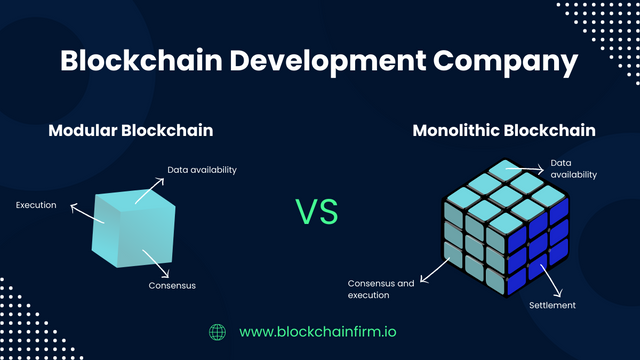
In recent years, the world has witnessed the rise of blockchain technology and the increasing number of use cases in various industries. One of the most significant advancements in this field is the development of modular and monolithic blockchains.
These two blockchain architectures have key differences in terms of their functions and the way they execute transactions.
Let’s discuss the major differences between the modular and monolithic blockchain in this blog.
𝐄𝐱𝐩𝐥𝐨𝐫𝐢𝐧𝐠 𝐌𝐨𝐧𝐨𝐥𝐢𝐭𝐡𝐢𝐜 𝐁𝐥𝐨𝐜𝐤𝐜𝐡𝐚𝐢𝐧
A monolithic blockchain has all the necessary functionalities built into its base layer. This means that the blockchain network executes all four functionalities, including consensus, execution, data availability, and settlement, in the same layer. The most prominent examples of monolithic blockchains are Bitcoin and Ethereum.
𝑯𝒊𝒈𝒉𝒍𝒊𝒈𝒉𝒕𝒔 𝑨𝒏𝒅 𝑪𝒉𝒂𝒍𝒍𝒆𝒏𝒈𝒆𝒔 𝑶𝒇 𝑴𝒐𝒏𝒐𝒍𝒊𝒕𝒉𝒊𝒄 𝑩𝒍𝒐𝒄𝒌𝒄𝒉𝒂𝒊𝒏
𝘔𝘰𝘯𝘰𝘭𝘪𝘵𝘩𝘪𝘤 𝘣𝘭𝘰𝘤𝘬𝘤𝘩𝘢𝘪𝘯 𝘩𝘢𝘴 𝘴𝘦𝘷𝘦𝘳𝘢𝘭 𝘣𝘦𝘯𝘦𝘧𝘪𝘵𝘴, 𝘪𝘯𝘤𝘭𝘶𝘥𝘪𝘯𝘨:
𝑷𝒓𝒐𝒕𝒆𝒄𝒕𝒊𝒐𝒏 & 𝑺𝒆𝒄𝒖𝒓𝒊𝒕𝒚
Monolithic blockchain can put secure transactions in force on their own nodes, ensuring data security and protection.
𝑼𝒔𝒂𝒈𝒆
Monolithic blockchains are easy to recognize and relatively simpler to implement and design.
𝘏𝘰𝘸𝘦𝘷𝘦𝘳, 𝘵𝘩𝘦𝘺 𝘢𝘭𝘴𝘰 𝘩𝘢𝘷𝘦 𝘴𝘦𝘷𝘦𝘳𝘢𝘭 𝘤𝘩𝘢𝘭𝘭𝘦𝘯𝘨𝘦𝘴, 𝘪𝘯𝘤𝘭𝘶𝘥𝘪𝘯𝘨:
𝑰𝒏𝒇𝒍𝒆𝒙𝒊𝒃𝒊𝒍𝒊𝒕𝒚
Monolithic blockchains are inflexible in comparison to modular blockchains, affecting production quality. They do not allow for an outstanding function even when there is downtime resulting from overload.
𝑪𝒆𝒏𝒕𝒓𝒂𝒍𝒊𝒛𝒂𝒕𝒊𝒐𝒏
When big block sizes are applied, high throughput becomes a trade-off for high hardware costs, decreasing the variety of validators on the chain, which causes centralization.
𝐄𝐱𝐩𝐥𝐨𝐫𝐢𝐧𝐠 𝐌𝐨𝐝𝐮𝐥𝐚𝐫 𝐁𝐥𝐨𝐜𝐤𝐜𝐡𝐚𝐢𝐧
A modular blockchain separates the system into several possible parts or additives that are independently developed. This means that the execution layer is independent of the bottom consensus and data availability layers, permitting nodes to execute transactions separately rather than performing all the transactions to test validity within a limited space or block. The most prominent examples of modular blockchains are Cosmos, Fuel, and Celestia blockchains.
For better blockchain development services, get in touch with Blockchain Firm, who has more than half a decade of experience.
𝑻𝒉𝒆 𝑲𝒆𝒚 𝑭𝒆𝒂𝒕𝒖𝒓𝒆𝒔 𝑶𝒇 𝑴𝒐𝒅𝒖𝒍𝒂𝒓 𝑩𝒍𝒐𝒄𝒌𝒄𝒉𝒂𝒊𝒏
The modular blockchain consists of 3 core layers that work independently to make its output easier and quicker. These layers are the consensus layer, data availability layer, and execution layer.
The consensus layer establishes the set of guidelines to be observed through nodes for verifying and validating blocks and agreeing on a canonical blockchain state. The data availability layer manages the on-chain and stale-chain blockchain records, making sure that records are available and public for everybody to look at.
𝑯𝒊𝒈𝒉𝒍𝒊𝒈𝒉𝒕𝒔 𝑨𝒏𝒅 𝑪𝒉𝒂𝒍𝒍𝒆𝒏𝒈𝒆𝒔 𝑶𝒇 𝑴𝒐𝒅𝒖𝒍𝒂𝒓 𝑩𝒍𝒐𝒄𝒌𝒄𝒉𝒂𝒊𝒏
𝘔𝘰𝘥𝘶𝘭𝘢𝘳 𝘣𝘭𝘰𝘤𝘬𝘤𝘩𝘢𝘪𝘯 𝘩𝘢𝘴 𝘴𝘦𝘷𝘦𝘳𝘢𝘭 𝘣𝘦𝘯𝘦𝘧𝘪𝘵𝘴, 𝘪𝘯𝘤𝘭𝘶𝘥𝘪𝘯𝘨:
𝑭𝒍𝒆𝒙𝒊𝒃𝒊𝒍𝒊𝒕𝒚
Modular blockchains are more flexible than monolithic blockchains, which allows for a better and smoother production quality. They allow for an outstanding function when there is downtime resulting from overhead.
𝑫𝒆𝒄𝒆𝒏𝒕𝒓𝒂𝒍𝒊𝒛𝒂𝒕𝒊𝒐𝒏
Modular blockchains ensure true security and decentralization through their consensus layer, making them more reliable and trustworthy.
𝘏𝘰𝘸𝘦𝘷𝘦𝘳, 𝘵𝘩𝘦𝘺 𝘢𝘭𝘴𝘰 𝘩𝘢𝘷𝘦 𝘴𝘦𝘷𝘦𝘳𝘢𝘭 𝘤𝘩𝘢𝘭𝘭𝘦𝘯𝘨𝘦𝘴, 𝘪𝘯𝘤𝘭𝘶𝘥𝘪𝘯𝘨:
𝑪𝒐𝒎𝒑𝒍𝒆𝒙𝒊𝒕𝒚
Modular blockchains are more complex than monolithic blockchains, which makes them harder to implement and design.
𝐂𝐨𝐧𝐜𝐥𝐮𝐬𝐢𝐨𝐧
Blockchain has undergone a significant evolution in recent years, leading to the development of these two architectures. Hope you understand the key differences between monolithic and modular blockchains. Ultimately, both have their place in the blockchain ecosystem, and the choice between them will depend on the needs and objectives of each application.
Are you searching for a team to integrate blockchain into your business? Connect with the leading Blockchain development company that helps you with customizable and affordable services.